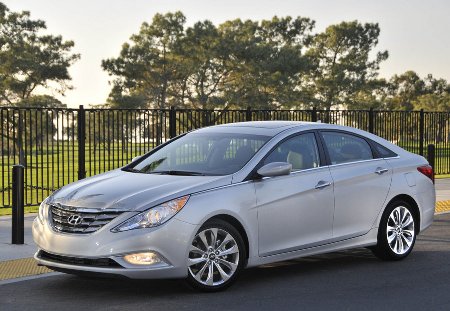2011 Hyundai sonata GLS Tops popular Competitors, including premium brands, in alg residual value index
FOUNTAIN VALLEY, Calif., (Feb. 8, 2010) – Hyundai’s completely redesigned 2011 Sonata that delivers best-in-class fuel economy and 200 horsepower is setting the standard for residual values as well. Right out of the box, the Hyundai Sonata GLS with automatic transmission received an impressive 36-month residual value of 54 percent of manufacturer’s suggested retail price (MSRP) from Automotive Lease Guide (ALG), the industry benchmark for residual values and a leading provider of data and consulting services to the automotive industry. The residual value topped popular competitive 2010 models from Toyota, Nissan, Ford, and Chevrolet, in addition to premium brands such as Lexus, BMW and Mercedes.
This represents the lowest depreciation in the midsize car segment. The 2011 Sonata even outperforms Honda, depreciating $640 over a three-year period less than a comparably-equipped 2010 model year Accord. Strong residuals add to Sonata’s value equation, indicating higher trade-in value for buyers and lower monthly payment for lessees.
The new 2011 Sonata, built at Hyundai Motor Manufacturing Alabama, has attributes which set a new standard in the midsize car category, such as a best-in-class 35 mpg highway fuel economy rating thanks to a new 2.4-liter Gasoline Direct Injection (GDI) four-cylinder engine, new six-speed manual and automatic transmissions and highly refined aerodynamics. A well-equipped 2.4-liter GDI I4 GLS model, offering 198 horsepower and six-speed manual transmission begins at $19,195. A fully-equipped Sonata Limited with a navigation package and six-speed automatic transmission is $27,395.
The 2011 Sonata represents a modern approach to the traditional midsize sedan segment using advanced four-cylinder engines, emotional design and luxury features, all combined with Hyundai’s strong value proposition. Sonata brings advancements like HD Radio Technology™ with Multicasting and standard Bluetooth connectivity to the segment for the first time ever.
“Hyundai’s model lineup continues to evolve and the completely redesigned 2011 Sonata punctuates the tremendous evolution in Hyundai performance, design, safety and quality,” said Troy Saito, manager of pricing management, Hyundai Motor America. “Strong residual value has become another element in Hyundai’s overall value equation, reducing the overall cost of ownership and allowing us to offer strong lease options to our customers."
2011 HYUNDAI SONATA NAMED “TOP SAFETY PICK” BY IIHS
FOUNTAIN VALLEY, Calif., Feb. 18, 2010 – Today, the all-new 2011 Hyundai Sonata joins an elite group of motor vehicles as a “Top Safety Pick” of the Insurance Institute for Highway Safety (IIHS).
This award is only given to those vehicles that do a superior job protecting people in front, side, rear and rollover crashes. A car’s ability to handle itself in these crashes is determined by how many “GOOD” ratings it receives in each of the IIHS tests. Additionally, the vehicle must have electronic stability control readily available as an option.
Sonata is built from the ground up with safety in mind, with a hot stamped ultra-high-strength steel body structure, advanced airbag technology and Electronic Stability Control (ESC), delivering on Hyundai’s commitment to both active and passive safety technology leadership. In 2005, the Sonata was the first popular midsize sedan to standardize ESC-- once again every 2011 Sonata has lifesaving ESC as standard equipment. This is important because the National Highway Traffic Safety Administration (NHTSA) has reported that ESC results in 35 percent fewer single-vehicle crashes and 30 percent fewer single-vehicle fatalities in passenger cars.
The Sonata also features a state-of-the-art Anti-Lock Braking System (ABS) including Brake Assist and Electronic Brake-force Distribution (EBD). Sonata features six airbags—including dual front, front seat-mounted side-impact, and front and rear side curtain airbags—along with active front-seat head restraints.
While past Hyundai models, such as the Genesis, have been named IIHS “Top Safety Picks,” the standards are higher than ever for 2010, with a roof strength test added to the qualifications. According to the new guidelines, roofs must be more than double the strength of current federal requirements in order to better maintain vehicle integrity in the event of a rollover accident.
Because this roof strength test is so demanding, many of the vehicles that had previously been named “Top Safety Picks” were dropped from the list in 2010. From the 2011 Sonata’s inception, Hyundai engineers carefully considered the importance of roof strength and designed the newest edition to pass this high hurdle set by the IIHS.
The other IIHS “Top Safety Pick” standards are stringent as well — the institute's frontal crashworthiness evaluations are based on results of 40 mph frontal offset crash tests. Each vehicle's overall evaluation is based on measurements of intrusion into the occupant compartment, injury measures recorded on a dummy representing a 50th percentile male in the driver seat, and analysis of slow-motion film to assess how well the restraint system controlled dummy movement during the test.



0 comments:
Post a Comment